The Spatial and Temporal Evolution of Coordination Degree Concerning China’s Cultivated Land Green Utilization Efficiency and High-Quality Agricultural Development
Abstract
1. Introduction
2. Material and Methods
2.1. HAD Accounting Method
- (1)
- Construction of an original evaluation matrix. Supposing the existence of evaluation objects and evaluation indexes, the original evaluation matrix for HAD is set as follows:
- (2)
- Data standardization.where is the standardized matrix;
- (3)
- Calculation of index weights. Determining the weights of the evaluation indexes by using the entropy weight method, the concrete formula is as follows:where is the entropy value of the - index . is the weight of the - index . is the calculation of the weight of the - index in year .
- (4)
- Establishment of weighted normalized evaluation matrix. The weighted normalized evaluation matrix is established by combining the standardized matrix with the index weights .
- (5)
- Determination of positive and negative ideal solutions.where represents the positive ideal solution, and represents the negative ideal solution.
- (6)
- Calculation of Euclidean distance.where is the Euclidean distance between the positive ideal solution and per evaluation object. is the Euclidean distance between the negative ideal solution and per evaluation object.
- (7)
- Calculation of closeness.where ranges from [0,1]. The larger the is, the closer HAD is to the optimal level. represents that HAD been the highest, and represents that HAD been the lowest.
2.2. CLGUE Accounting Method
2.3. Coupling Coordination Degree Model
2.4. Global Spatial Autocorrelation
2.5. Analysis of Hot Spot (Partial Getis-Ord G* Index)
2.6. Area of Study and Data Source
3. Results and Analysis
3.1. HAD Measurement Analysis
3.2. CLGUE Measurement Analysis
3.3. Analysis of Coordination Degree Measurement
3.4. Analysis of Spatial Patterns for Coordination
3.4.1. Analysis of Global Spatial Autocorrelation
3.4.2. Analysis of Local Spatial Autocorrelation
4. Discussion
4.1. Policy Implications
4.2. Limitations and Future Recommendations
5. Conclusions
- (1)
- The present study revealed a true picture of the HAD and CLGUE at the national, regional, and provincial levels. The total HAD for China increased from 0.109 in 2006 to 0.198 in 2020, growing at an average yearly growth rate of 4.35%. Furthermore, China’s total CLGUE also showed a good trend, increasing from 0.533 in 2006 to 0.921 in 2020, with an average annual growth rate of 4.08%. However, the spatial disparities of HAD and CLGUE were significant from the food function areas and provincial angles during the study period. The HAD displayed an overall increasing trend from the perspective of the three food function areas, with the MGMAs having the fastest mean annual growth rates. Similar trends were observed in CLGUE, where CLGUE in three food function areas all displayed a general increasing tendency. However, the mean yearly growth rate of CLGUE was in the order MGPAs > MGMAs > GPMBAs.
- (2)
- The coordination degree concerning HAD and CLGUE in China has improved, with the annual value rising from 0.48 in 2006 to 0.64 in 2020. According to the three food function areas, the level of coordination degree concerning HAD and CLGUE exhibited an order of MGMAs > MGPAs > GPMBAs.. The level of coordination degree also varied significantly throughout the 31 provinces in terms of space and time due to the various environmental and economic factors. Throughout the study period, the level of coordination degree maintained an upward trend for all provinces. The provinces with higher coordination degree in regard to HAD and CLGUE tended to cluster around economically developed areas. In contrast, the provinces with lower coordination degree tended to cluster in underdeveloped areas or places with insufficient natural resources for agricultural development.
- (3)
- In terms of HAD and CLGUE, at the provincial level, the level of coordination degree in China had a significant positive spatial autocorrelation, clearly indicating space dependence and heterogeneity. There is a reduction to a certain extent in the coordination level of space aggregation and distribution of provinces with high or low degrees of coordination. Additionally, hot spot aggregation areas were concentrated in MGPAs. In contrast, cold spot aggregation areas were concentrated in Shaanxi and Chongqing, demonstrating the transition from hot spot aggregation areas in MGPAs to cold spot aggregation areas in GPMBAs. The conclusions provide an empirical reference for the policy maker of developing a pathway of high HAD and high CLGUE.
Author Contributions
Funding
Data Availability Statement
Acknowledgments
Conflicts of Interest
Notation list
References
- Kamali, F.P.; Borges, J.A.R.; Meuwissen, M.P.M.; de Boer, I.J.M. Sustainability assessment of agricultural systems: The validity of expert opinion and robustness of a multi-criteria analysis. Agric. Syst. 2017, 157, 118–128. [Google Scholar] [CrossRef]
- Blandford, D.; Braden, J.B.; Shortle, J.S. Economics of Natural Resources and Environment in Agriculture. In Encyclopedia of Agriculture and Food Systems; Academic Press: Cambridge, MA, USA, 2014; pp. 18–34. [Google Scholar] [CrossRef]
- FAO. The State of Food and Agriculture; Food & Agriculture Organization of the U.N.: Washington, DC, USA, 2016. [Google Scholar]
- Lu, X.H.; Kuang, B.; LI, J.; Han, J.; Zhang, Z. Dynamic evolution of regional discrepancies in carbon emissions from agricultural land utilization: Evidence from Chinese provincial data. Sustainability 2018, 10, 552. [Google Scholar] [CrossRef]
- Rural Social Economic Investigation Division, National Bureau of Statistics. China Rural Statistical Yearbook.2021. Available online: https://data.cnki.net/Yearbook/Single/N2021120010 (accessed on 25 October 2022).
- Lin, H.C.; Hülsbergen, K.J. A new method for analyzing agricultural land-use efficiency, and its application in organic and conventional farming systems in southern Germany. Europ. J. Agron. 2017, 83, 15–27. [Google Scholar] [CrossRef]
- Zhou, M.; Hu, B.X. Decoupling of carbon emissions from agricultural land utilisation from economic growth in China. Agric. Econ. 2020, 11, 510–518. [Google Scholar] [CrossRef]
- Alam, A. Soil Degradation: A Challenge to Sustainable Agriculture. Int. J. Sci. Res. Agric. Sci. 2014, 1, 50–55. [Google Scholar] [CrossRef]
- Zhang, F.M.; Ding, F.; Wang, P. Evalution of high-quality agricultural development level in major garin producing areas in China and its spatial and temporal evolution. Acta Agric. Zhejiangensis 2021, 33, 150–160. [Google Scholar]
- Wang, G.; Mi, L.; Hu, J.; Qian, Z. Spatial Analysis of Agricultural Eco-Efficiency and High-Quality Development in China. Front. Environ. Sci. 2022, 10, 847719. [Google Scholar] [CrossRef]
- Mohanty, A.K.; Vivekanandhan, S.; Pin, J.M.; Misra, M. Composites from renewable and sustainable resources Challenges and innovations. Science 2018, 362, 536–542. [Google Scholar] [CrossRef] [PubMed]
- Bain, P.G.; Kroonenberg, P.M.; Johansson, L.O.; Milfont, T.L.; Crimston, C.; Kurz, T.; Bushina, E.; Calligaro, C.; Demarque, C.; Guan, Y.J. Public views of the Sustainable Development Goals across countries. Nat. Sustain. Springer Nat. 2019, 2, 819–825. [Google Scholar] [CrossRef]
- Geng, Y.; Sarkis, J.; Ulgiati, S.; Zhang, P. Measuring China’s circular economy. Science 2013, 339, 1526–1527. [Google Scholar] [CrossRef]
- Schiller, D.; Reid, N.; Tamásy, C. Sustainable economies: Challenges, transitions and trajectories in spatial perspective. Appl. Geogr. 2018, 90, 293–295. [Google Scholar] [CrossRef]
- Pan, W.; Wang, J.; Lu, Z.; Liu, Y.S.; Li, Y.R. High-quality development in China: Measurement system, spatial pattern, and improvement paths. Habitat Int. 2021, 118, 102458. [Google Scholar] [CrossRef]
- The Central Conference on Rural Work was held in Beijing, published by Ministry of Agriculture and Rural Affairs of the People’s Republic of China. Available online: http://www.moa.gov.cn/ztzl/ncgzhy2017/zxdt/201801/t20180103_6133744.htm (accessed on 11 October 2022).
- Notice of the Ministry of Agriculture on starting the Work of 2018 Agricultural Quality Year, published by Ministry of Agriculture and Rural Affairs of the People’s Republic of China. Available online: http://www.moa.gov.cn/nybgb/2018/201803/201805/t20180528_6143195.htm (accessed on 11 October 2022).
- Cui, X.F.; Cai, T.; Deng, W.; Zheng, R.; Jiang, Y.H.; Bao, H.J. Indicators for Evaluating High-Quality Agricultural Development: Empirical Study from Yangtze River Economic Belt, China. Soc. Indic. Res. 2022, 14, 1–27. [Google Scholar] [CrossRef] [PubMed]
- Lu, X.; Li, Z.; Wang, H.; Tang, Y.; Hu, B.; Gong, M.; Li, Y. Evaluating Impact of Farmland Recessive Morphology Transition on High-Quality Agricultural Development in China. Land 2022, 11, 435. [Google Scholar] [CrossRef]
- Qin, S.; Han, Z.Y.; Chen, H.; Wang, H.K.; Guo, C. High-Quality Development of Chinese Agriculture under Factor Misallocation. Int. J. Environ. Res. Public Health 2022, 19, 9804. [Google Scholar] [CrossRef] [PubMed]
- Xia, X.L.; Chen, Z.; Zhang, H.L.; Zhao, M.J. Agricultural High-quality Development: Digital Empowerment and Implementation Path. Chin. Rural. Econ. 2019, 12, 2–15. [Google Scholar]
- Bender, S.F.; Wagg, C.; van der Heijden, M.G.A. An Underground Revolution: Bio-diversity and Soil Ecological Engineering for Agricultural Sustainability. Trends Ecol. Evol. 2016, 31, 440–452. [Google Scholar] [CrossRef]
- Zeng, S.; Shu, X.; Ye, W. Total Factor Productivity and High-Quality Economic Development: A Theoretical and Empirical Analysis of the Yangtze River Economic Belt, China. Int. J. Environ. Res. Public Health 2022, 19, 2783. [Google Scholar] [CrossRef]
- Wang, Y.F.; Xie, L.; Zhang, Y.; Wang, C.Y.; Yu, K. Does FDI Promote or Inhibit the High-Quality Development of Agriculture in China? An Agricultural GTFP Perspective. Sustainability 2019, 11, 4620. [Google Scholar] [CrossRef]
- Gong, R.; Xie, L.; Wang, Y.F. Interactive Mechanism and Empirical Test of Agricultural High-quality Development and New Urbanization. Reform 2020, 317, 145–159. [Google Scholar]
- Long, S.B.; Zhang, M.X. Re-measurement and influence factors of agricultural total factor Productivity in China—From tradition to high-quality development. Res. Financ. Econ. Issues 2021, 8, 40–51. [Google Scholar]
- Liu, Z.Y.; Wakasi, R. A Research of the Regional Disparities and Distributional Dynamic Evolution of High-quality Agricultural Development in China. Quant. Tech. Econ. 2021, 6, 28–44. [Google Scholar]
- Liu, T.; Li, J.X.; Huo, J.J. Spatial-temporal pattern and influencing factors of high-quality agricultural development in China. J. Arid. Land Resour. Environ. 2020, 34, 1–8. [Google Scholar]
- Chen, Q.R.; Xie, H.L. Temporal-Spatial Differentiation and Optimization Analysis of Cultivated Land Green Utilization Efficiency in China. Land 2019, 8, 158. [Google Scholar] [CrossRef]
- Deng, X.Z.; Huang, J.K.; Rozelle, S.; Zhang, J.P.; Li, Z.H. Impact of urbanization on cultivated land changes in China. Land Use Policy 2015, 45, 1–7. [Google Scholar] [CrossRef]
- Yang, B.; Wang, Z.Q.; Zou, L.; Zhang, H.W. Exploring the eco-efficiency of cultivated land utilization and its influencing factors in China’s Yangtze River Economic Belt, 2001–2018. J. Environ. Manag. 2021, 294, 112939. [Google Scholar] [CrossRef]
- Brauw, A.D.; Huang, K.K.; Rozelle, S. The sequencing of reform policies in China’s agricultural transition. Econ. Transit. Inst. Change 2004, 12, 427–465. [Google Scholar] [CrossRef]
- Lai, Z.H.; Chen, M.Q.; Liu, T.J. Changes in and prospects for cultivated land use since the reform and opening up in China. Land Use Policy 2020, 97, 104781. [Google Scholar] [CrossRef]
- Deng, X.Z.; Huang, K.K.; Rozelle, S.; Uchida, E. Cultivated land conversion and potential agricultural productivity in China. Land use policy 2006, 23, 372–384. [Google Scholar] [CrossRef]
- Li, Y.L.; Ma, W.Q.; Jiang, G.H.; Li, G.Y.; Zhou, D.Y. The degree of cultivated land abandonment and its influence on grain yield in main grain producing areas of China. J. Nat. Resour. 2021, 36, 1439–1454. [Google Scholar] [CrossRef]
- Berry, R.A.; Cline, W.R. Agrarian Structure and Productivity in Developing Countries. Land Econ. 1980, 56, 495–502. [Google Scholar] [CrossRef]
- Sen, A.K. Peasants and Dualism with or without Surplus Labor. J. Political Econ. 1966, 74, 425–450. Available online: http://www.jstor.org/stable/1829592 (accessed on 9 October 2022).
- Helfand, S.M.; Levine, E.S. Farm size and the determinants of productive efficiency in the Brazilian Center-West. Agric. Econ. 2004, 31, 241–249. [Google Scholar] [CrossRef]
- Lu, X.; Qu, Y.; Sun, P.L.; Yu, W.; Peng, W.L. Green transition of cultivated land use in the Yellow River Basin: A perspective of green utilization efficiency evaluation. Land 2020, 9, 475. [Google Scholar] [CrossRef]
- Xie, H.L.; Chen, Q.R.; Wang, W.; He, Y.F. Analyzing the green efficiency of arable land use in China. Technol. Forecast. Soc. Chang. 2018, 133, 15–28. [Google Scholar] [CrossRef]
- Ke, N.; Lu, X.H.; Kuang, B.; Han, J. Regional Differences and Influencing Factors of Green and Low-carbon Utilization of Cultivated Land under the Carbon Neutrality Target in China. China Land Sci. 2021, 35, 67–76. [Google Scholar]
- Zhou, M.; Zhang, H.; Ke, N. Cultivated Land Transfer, Management Scale, and Cultivated Land Green Utilization Efficiency in China: Based on Intermediary and Threshold Models. Int. J. Environ. Res. Public Health 2022, 19, 12786. [Google Scholar] [CrossRef] [PubMed]
- Zhou, M.; Kuang, B.; Zhou, M.; Ke, N. The Spatial and Temporal Evolution of the Coordination Degree in Regard to Farmland Transfer and Cultivated Land Green Utilization Efficiency in China. Int. J. Environ. Res. Public Health 2022, 19, 10208. [Google Scholar] [CrossRef]
- Qu, Y.; Lyu, X.; Peng, W.; Xin, Z. How to Evaluate the Green Utilization Efficiency of Cultivated Land in a Farming Household? A Case Study of Shandong Province, China. Land 2021, 10, 789. [Google Scholar] [CrossRef]
- Yang, M.; Jiao, M.Y.; Zhang, J.Y. Spatio-Temporal Analysis and Influencing Factors of Rural Resilience from the Perspective of Sustainable Rural Development. Int. J. Environ. Res. Public Health 2022, 19, 12294. [Google Scholar] [CrossRef]
- Li, X.F. TOPSIS model with entropy weight for eco geological environmental carrying capacity assessment. Microprocess. Microsyst. 2021, 82, 103805. [Google Scholar] [CrossRef]
- Tone, K. A slacks-based measure of efficiency in data envelopment analysis. Eur. J. Oper. Res 2001, 130, 498–509. [Google Scholar] [CrossRef]
- Pan, D.; Ying, R.Y. Agricultural eco-efficiency evaluation in China based on SBM model. Acta Ecol. Sin. 2013, 33, 3837–3845. [Google Scholar] [CrossRef]
- Ma, D.D.; Li, G.F.; He, F. Exploring PM2.5 Environmental Efficiency and Its Influencing Factors in China. Int. J. Environ. Res. Public Health 2021, 18, 12218. [Google Scholar] [CrossRef] [PubMed]
- West, T.O.; Marland, G.A. Synthesis of carbon sequestration, carbon emissions, and net carbon flux in agriculture: Comparing tillage practices in the United States. Agric. Ecosyst. Environ 2002, 91, 217–232. [Google Scholar] [CrossRef]
- Ke, N.; Zhang, X.; Lu, X.; Kuang, B.; Jiang, B. Regional Disparities and Influencing Factors of Eco-Efficiency of Arable Land Utilization in China. Land 2022, 11, 257. [Google Scholar] [CrossRef]
- Liang, L.; Zhang, F.; Wu, F.; Chen, Y.X.; Qin, K.Y. Coupling coordination degree spatial analysis and driving factor between socio-economic and eco-environment in northern China. Ecol. Indic. 2022, 135, 108555. [Google Scholar] [CrossRef]
- Li, D.; Fan, K.; Lu, J.; Wu, S.; Xie, X. Research on Spatio-Temporal Pattern Evolution and the Coupling Coordination Relationship of Land-Use Benefit from a Low-Carbon Perspective: A Case Study of Fujian Province. Land 2022, 11, 1498. [Google Scholar] [CrossRef]
- Shi, T.; Yang, S.Y.; Zhang, W.; Zhou, Q. Coupling coordination degree measurement and spatiotemporal heterogeneity between economic development and ecological environment—Empirical evidence from tropical and subtropical regions of China. J. Clean. Prod. 2020, 244, 118739. [Google Scholar] [CrossRef]
- Wang, S.J.; Kong, W.; Ren, L.; Zhi, D.D.; Dai, B.T. Research on misuses and modification of coupling coordination degree model in China. J. Nat. Resour. 2021, 36, 793–810. [Google Scholar] [CrossRef]
- Lu, C.Y.; Wang, D.; Li, H.J.; Cheng, W.; Tang, X.L.; Liu, W. Measurement of the Degree of Coordination in Regard to Carbon Emissions, Economic Development, and Environmental Protection in China. Appl. Sci 2021, 11, 1750. [Google Scholar] [CrossRef]
- Chi, M.J.; Guo, Q.Y.; Mi, L.C.; Wang, G.F.; Song, W.M. Spatial Distribution of Agricultural Eco-Efficiency and Agriculture High-Quality Development in China. Land 2022, 11, 722. [Google Scholar] [CrossRef]
- Li, D.L.; Cao, L.J.; Zhou, Z.H.; Zhou, K.K.; Du, Z.N.; Han, K.Q. Coupling coordination degree and driving factors of new-type urbanization and low-carbon development in the Yangtze River Delta: Based on nighttime light data. Environ. Sci. Pollut. Res. 2022, 29, 81636–81657. [Google Scholar] [CrossRef] [PubMed]
- Anselin, L.; Getis, A. Spatial statistical analysis and geographic information systems. Ann. Reg. Sci. 1992, 26, 19–33. Available online: https://EconPapers.repec.org/RePEc:spr:anresc:v:26:y:1992:i:1:p:19-33 (accessed on 10 October 2022).
- Qi, Y.J.; Yang, Y.; Jin, F.J. China’s economic development stage and its patio-temporal evolution: A prefectural-level analysis. Acta Geogr. Sin. 2013, 68, 517–531. [Google Scholar]
- Liu, X.Y.; Xin, Y. Exploring the characteristics and driving factors of coupling coordination of regional sustainable development: Evidence from China’s 31 provinces. Environ. Sci. Pollut. Res. 2022, 29, 71075–71099. [Google Scholar] [CrossRef] [PubMed]
- Lin, J.; Li, D.X. Non-agricultural employment and grain production: Substitute or complement—Analysis based on the perspective of farmers in major grain producing areas. Chin. Rural. Econ. 2013, 9, 54–62. [Google Scholar]
- Luo, S.X.; He, K.; Zhang, J.B. The More Grain Production, the More Fertilizers Pollution? Empirical Evidence from Major Grain-producing Areas in China. Chin. Rural. Econ. 2013, 9, 108–131. [Google Scholar]
- Huang, H.P.; Wang, Z.P. Spatial-temporal Differences and Influencing Factors of Agricultural Land Eco-efficiency in Jiangxi Province: Based on the Dual Perspective of Non-point Source Pollution and Carbon Emission. Resour. Environ. Yangtze Basin 2022, 29, 412–423. [Google Scholar]
- Zulfiqar, F.; Thapa, G.B. Agricultural sustainability assessment at provincial level in Pakistan. Land Use Policy 2017, 68, 492–502. [Google Scholar] [CrossRef]
- Bartkowiak, A.; Bartkowiak, P. Technical and Technological Progress in the Context of Sustainable Development of Agriculture in Poland. Procedia Eng. 2017, 182, 66–75. [Google Scholar] [CrossRef]
- Ke, S.G.; Cui, H.Y.; Lu, X.H.; Hou, J.; Wu, Y.Q. Research on the Spatial-Temporal Pattern and Mechanisms of Green Transition of Farmland Use: A Case of Hubei Province. China Land Sci. 2021, 35, 64–74. [Google Scholar]
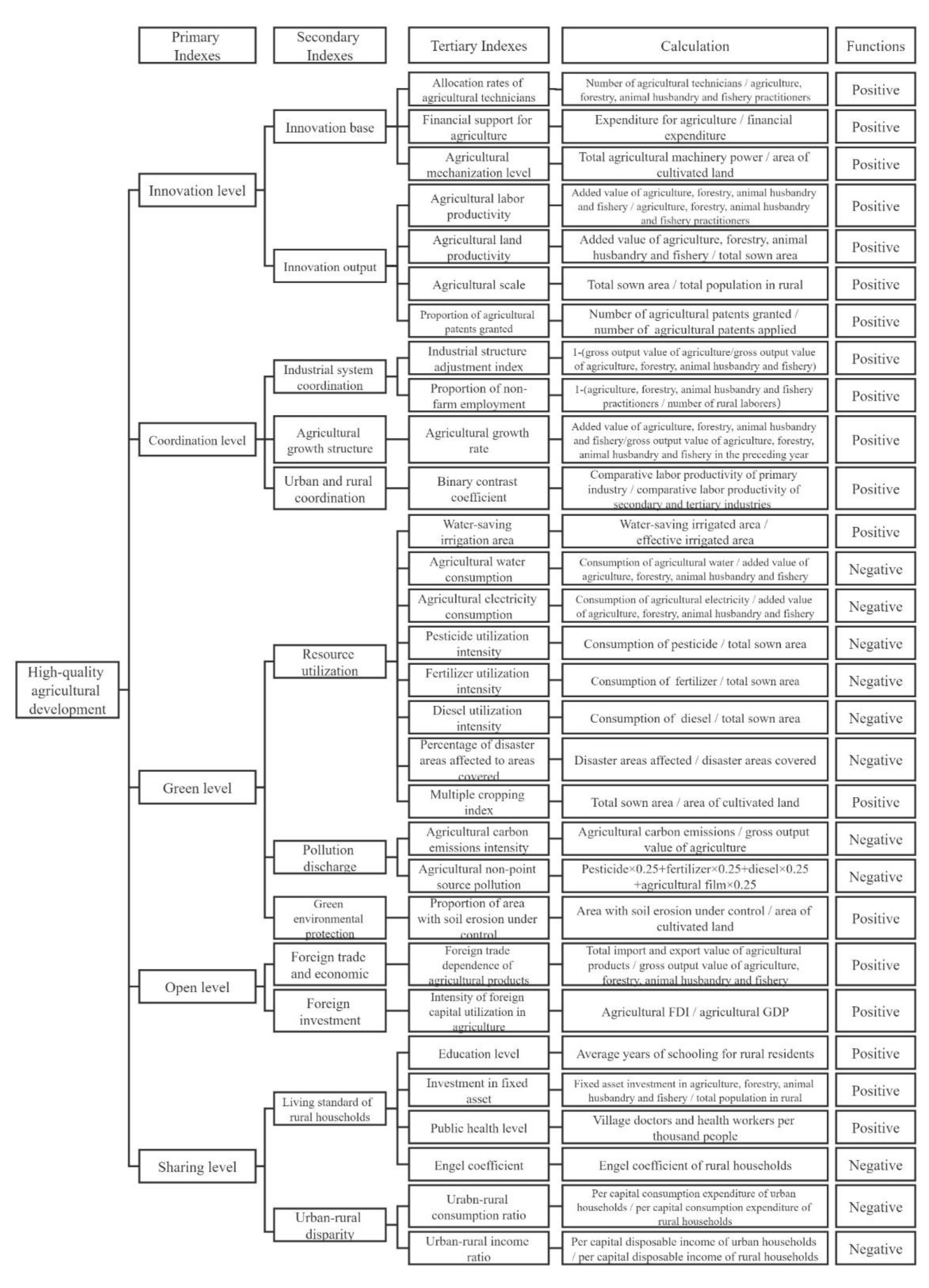
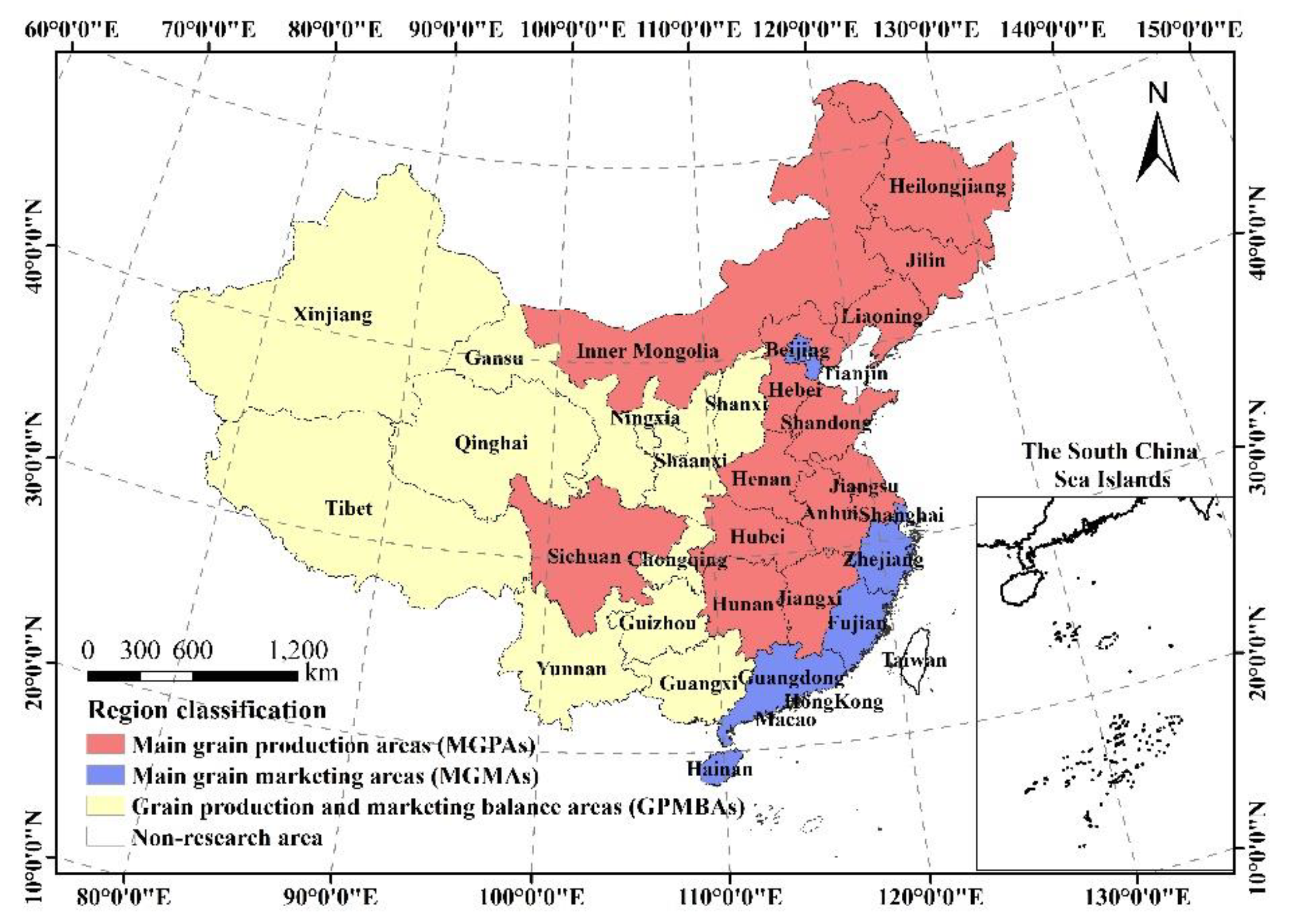

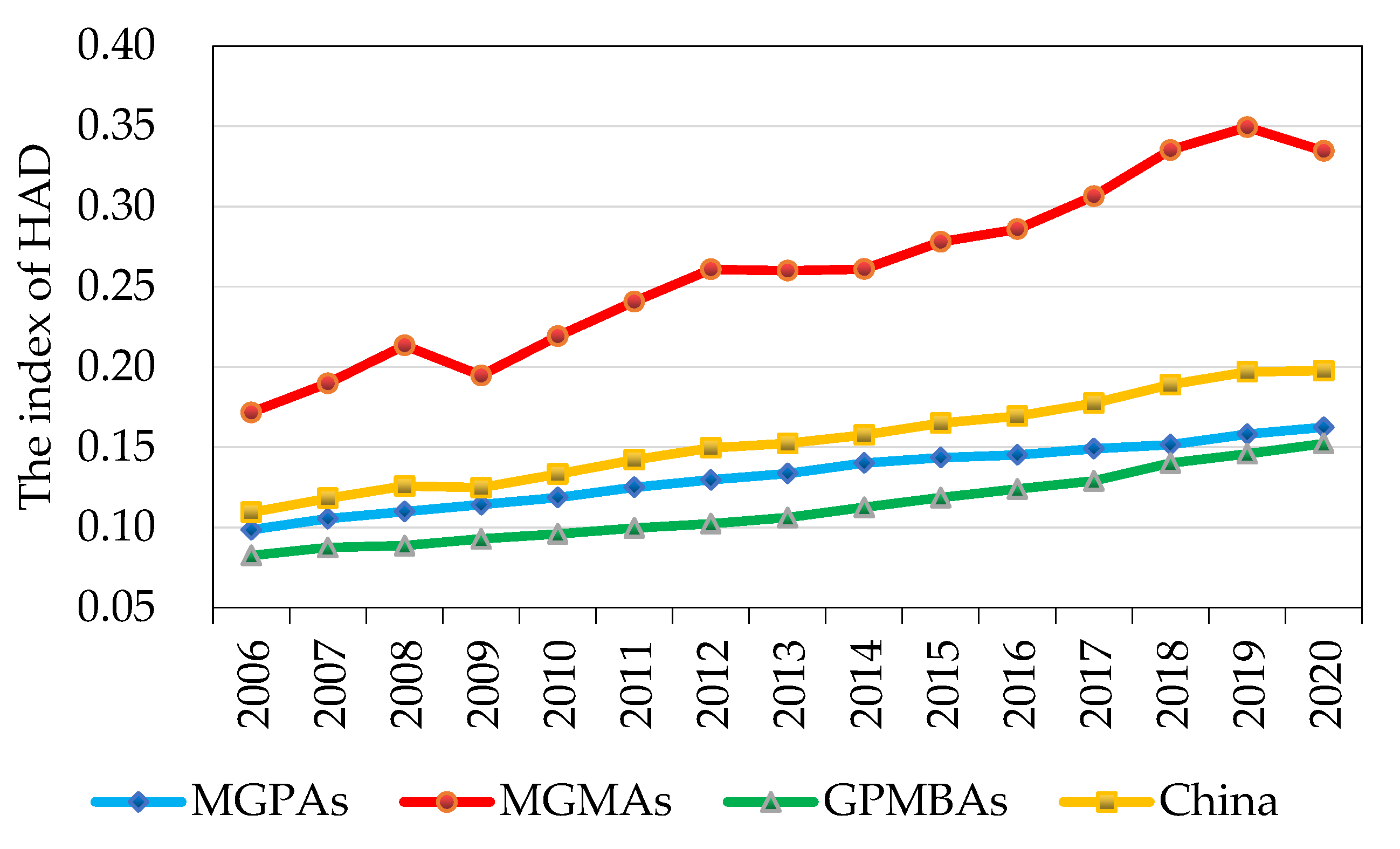

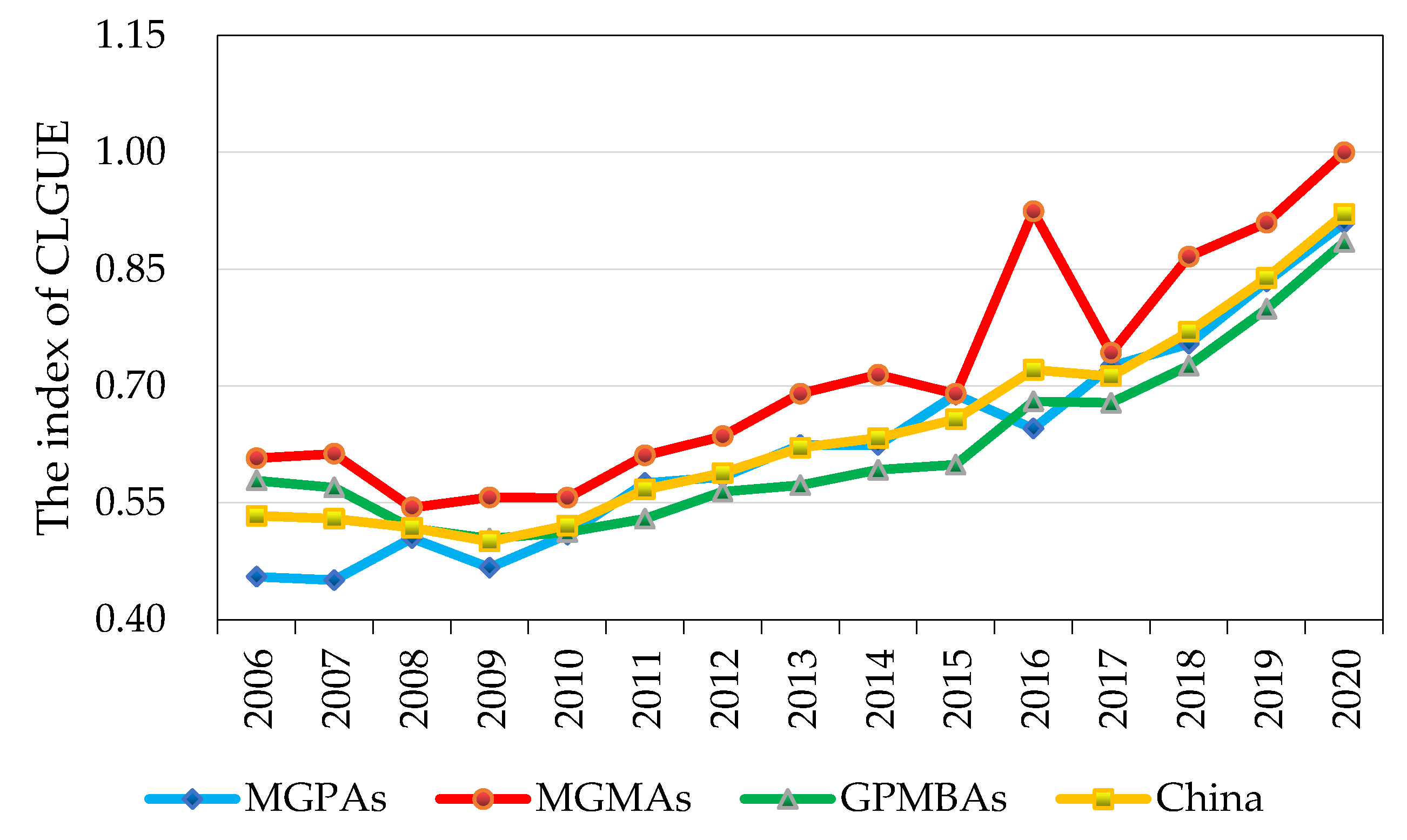
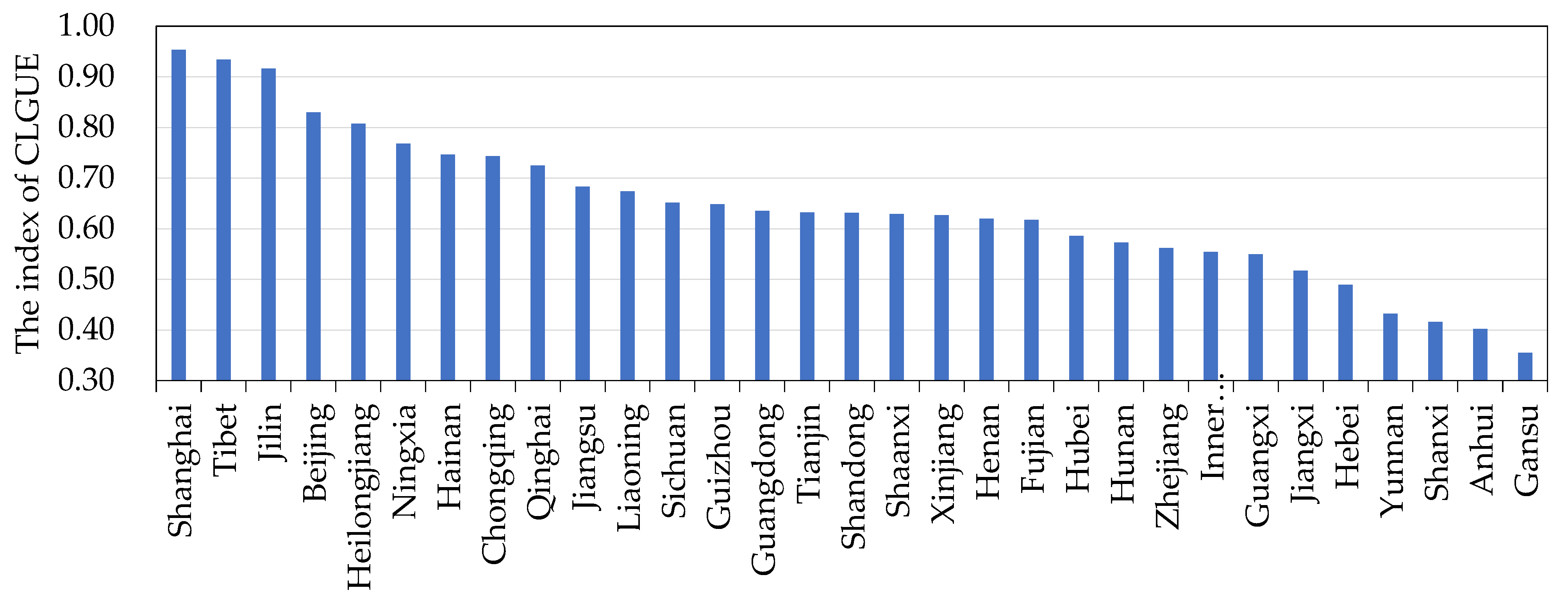

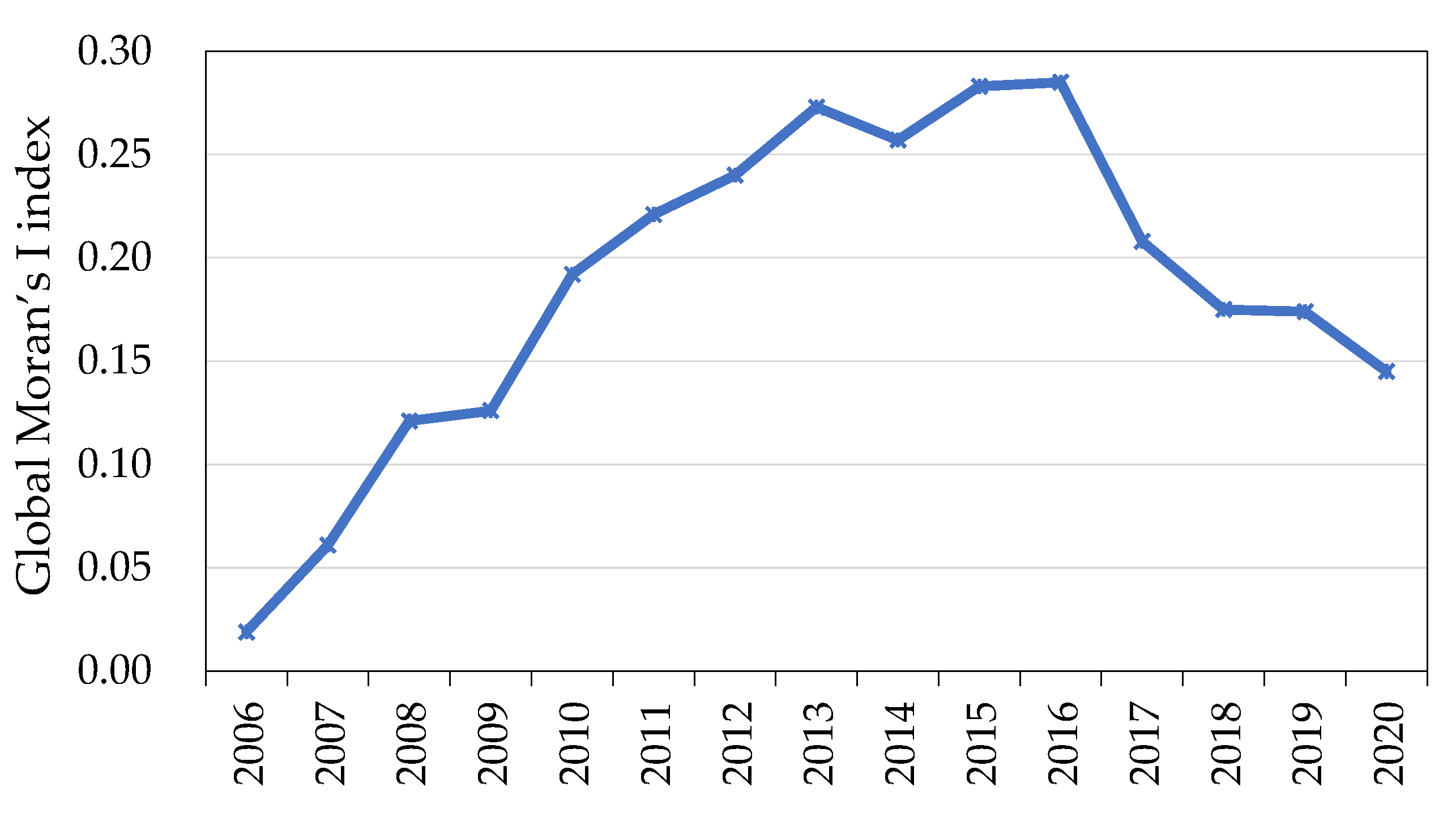

| Primary Indexes | Secondary Indexes | Variates and Descriptions |
|---|---|---|
| Inputs | Labor input | AFAHF × (Total agriculture output/TO) (104 people) |
| Land input | The total area of crops sowed (103 hectares) | |
| Capital input | Consumption of chemical manures (104 tons) | |
| Consumption of pesticide (104 tons) | ||
| Consumption of agriculture film (104 tons) | ||
| Total agriculture machinery power (104 kw · h) | ||
| Valid irrigation area (103 hm2) | ||
| Desirable Outputs | Economic output | Total agricultural output (104 Yuan) |
| Social output | Total grain production (104 tons) | |
| Environmental output | The total carbon sink (104 tons) | |
| Undesirable Outputs | Pollution emission | The total loss of manure nitrogen (phosphorus), insecticides and agriculture films (104 tons) |
| Carbon emission | The carbon emissions from cultivated land utilization (104 tons) |
| Coupling Coordination Degree | Type | Coupling Coordination Degree | Type |
|---|---|---|---|
| (0,0.1] | Extreme imbalance | (0.5,0.6] | Reluctant coordination |
| (0.1,0.2] | Serious imbalance | (0.6,0.7] | Primary coordination |
| (0.2,0.3] | Moderate imbalance | (0.7,0.8] | Intermediate coordination |
| (0.3,0.4] | Mid imbalance | (0.8,0.9] | Good coordination |
| (0.4,0.5] | Near imbalance | (0.9,1.0] | High coordination |
| Region | Province | 2006 | 2009 | 2012 | 2015 | 2018 | 2020 | Average |
|---|---|---|---|---|---|---|---|---|
| Main grain production areas (MGPAs) | Hebei | 0.42 | 0.46 | 0.51 | 0.54 | 0.56 | 0.60 | 0.51 |
| Inner Mongolia | 0.45 | 0.46 | 0.50 | 0.53 | 0.57 | 0.64 | 0.52 | |
| Liaoning | 0.47 | 0.48 | 0.54 | 0.57 | 0.56 | 0.60 | 0.54 | |
| Jilin | 0.55 | 0.51 | 0.56 | 0.60 | 0.60 | 0.61 | 0.57 | |
| Heilongjiang | 0.49 | 0.53 | 0.57 | 0.59 | 0.64 | 0.67 | 0.58 | |
| Jiangsu | 0.46 | 0.50 | 0.56 | 0.62 | 0.64 | 0.67 | 0.57 | |
| Anhui | 0.41 | 0.44 | 0.46 | 0.48 | 0.50 | 0.52 | 0.46 | |
| Jiangxi | 0.45 | 0.47 | 0.49 | 0.51 | 0.55 | 0.57 | 0.50 | |
| Shandong | 0.44 | 0.49 | 0.54 | 0.64 | 0.60 | 0.64 | 0.55 | |
| Henan | 0.45 | 0.48 | 0.51 | 0.55 | 0.60 | 0.63 | 0.53 | |
| Hubei | 0.43 | 0.45 | 0.50 | 0.53 | 0.56 | 0.63 | 0.51 | |
| Hunan | 0.45 | 0.48 | 0.52 | 0.55 | 0.56 | 0.62 | 0.53 | |
| Sichuan | 0.45 | 0.47 | 0.49 | 0.52 | 0.59 | 0.63 | 0.52 | |
| Main grain marketing areas (MGMAs) | Beijing | 0.67 | 0.67 | 0.78 | 0.82 | 0.89 | 0.90 | 0.79 |
| Tianjin | 0.53 | 0.57 | 0.63 | 0.67 | 0.69 | 0.72 | 0.63 | |
| Shanghai | 0.71 | 0.76 | 0.81 | 0.79 | 0.80 | 0.82 | 0.79 | |
| Zhejiang | 0.46 | 0.49 | 0.54 | 0.56 | 0.61 | 0.68 | 0.56 | |
| Fujian | 0.45 | 0.48 | 0.54 | 0.58 | 0.65 | 0.70 | 0.56 | |
| Guangdong | 0.46 | 0.48 | 0.53 | 0.56 | 0.76 | 0.75 | 0.57 | |
| Hainan | 0.55 | 0.49 | 0.53 | 0.56 | 0.64 | 0.66 | 0.56 | |
| Grain production and marketing balance areas (GPMBAs) | Shanxi | 0.41 | 0.42 | 0.45 | 0.48 | 0.50 | 0.52 | 0.46 |
| Guangxi | 0.43 | 0.44 | 0.47 | 0.50 | 0.55 | 0.61 | 0.49 | |
| Chongqing | 0.46 | 0.49 | 0.52 | 0.55 | 0.58 | 0.62 | 0.54 | |
| Guizhou | 0.52 | 0.43 | 0.43 | 0.51 | 0.58 | 0.63 | 0.50 | |
| Yunnan | 0.40 | 0.41 | 0.43 | 0.46 | 0.50 | 0.57 | 0.45 | |
| Tibet | 0.55 | 0.57 | 0.58 | 0.56 | 0.62 | 0.63 | 0.58 | |
| Shaanxi | 0.44 | 0.46 | 0.50 | 0.55 | 0.63 | 0.69 | 0.53 | |
| Gansu | 0.39 | 0.40 | 0.42 | 0.45 | 0.46 | 0.49 | 0.43 | |
| Qinghai | 0.48 | 0.49 | 0.51 | 0.54 | 0.57 | 0.63 | 0.54 | |
| Ningxia | 0.54 | 0.50 | 0.51 | 0.55 | 0.60 | 0.62 | 0.54 | |
| Xinjiang | 0.42 | 0.45 | 0.51 | 0.52 | 0.56 | 0.62 | 0.51 | |
| Average | 0.48 | 0.49 | 0.53 | 0.56 | 0.60 | 0.64 | 0.55 | |
Disclaimer/Publisher’s Note: The statements, opinions and data contained in all publications are solely those of the individual author(s) and contributor(s) and not of MDPI and/or the editor(s). MDPI and/or the editor(s) disclaim responsibility for any injury to people or property resulting from any ideas, methods, instructions or products referred to in the content. |
© 2022 by the authors. Licensee MDPI, Basel, Switzerland. This article is an open access article distributed under the terms and conditions of the Creative Commons Attribution (CC BY) license (https://creativecommons.org/licenses/by/4.0/).
Share and Cite
Zhou, M.; Sun, H.; Ke, N. The Spatial and Temporal Evolution of Coordination Degree Concerning China’s Cultivated Land Green Utilization Efficiency and High-Quality Agricultural Development. Land 2023, 12, 127. https://doi.org/10.3390/land12010127
Zhou M, Sun H, Ke N. The Spatial and Temporal Evolution of Coordination Degree Concerning China’s Cultivated Land Green Utilization Efficiency and High-Quality Agricultural Development. Land. 2023; 12(1):127. https://doi.org/10.3390/land12010127
Chicago/Turabian StyleZhou, Min, Hanxiaoxue Sun, and Nan Ke. 2023. "The Spatial and Temporal Evolution of Coordination Degree Concerning China’s Cultivated Land Green Utilization Efficiency and High-Quality Agricultural Development" Land 12, no. 1: 127. https://doi.org/10.3390/land12010127
APA StyleZhou, M., Sun, H., & Ke, N. (2023). The Spatial and Temporal Evolution of Coordination Degree Concerning China’s Cultivated Land Green Utilization Efficiency and High-Quality Agricultural Development. Land, 12(1), 127. https://doi.org/10.3390/land12010127






